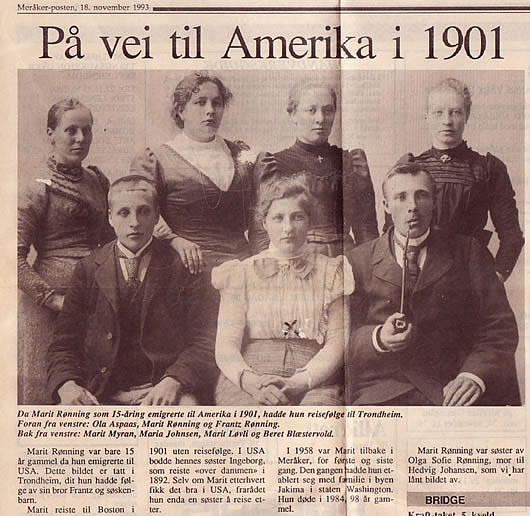
Franz som ung.
Franz følger sin søster Marit (15 år)
til Trondheim da hun skulle emigrere 1901. Marit i midten og
Franz foran til høyre.

Franz (Frank) Olsen Rønning (Renning) (1880 – 1948)
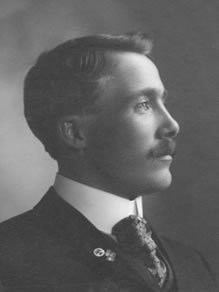
Frantz gikk på Mære Landbruksskole. Da var det ikke så vanlig da at de unge kunne få reise ut for å gå på skole. Franz Emigrerte til Amerika i 1902.
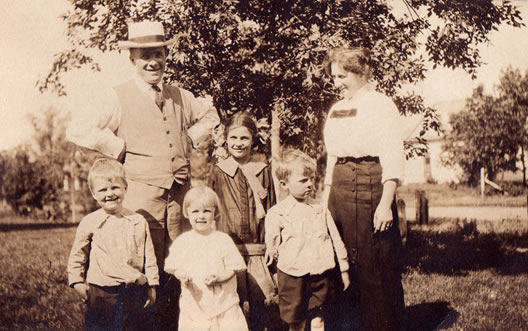
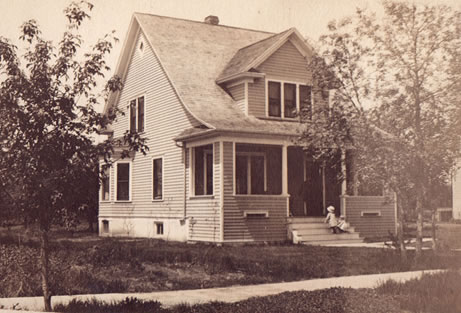
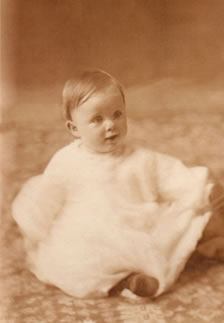
Franz og Amanda med barna
Arthur, Evelyn og Otto foran.
(Ukjent pike bak)
Datteren Evelyn
Huset familien bodde i med Otto og Evelyn på trappa.
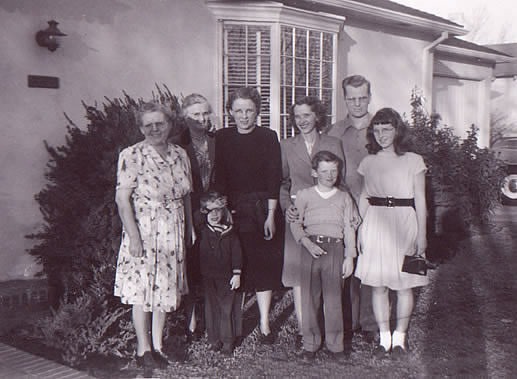
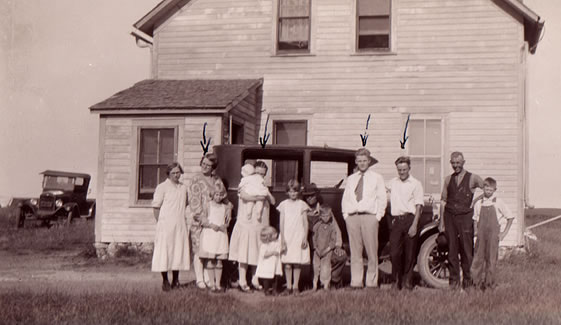
Noen etterkommere:
Amanda, Mrs. Wees (mor til Margaret),
Evelyn med John, Margaret med James,
Arthur med Mary.
Evelyn, Amanda, Arthur og Otto (med piler).
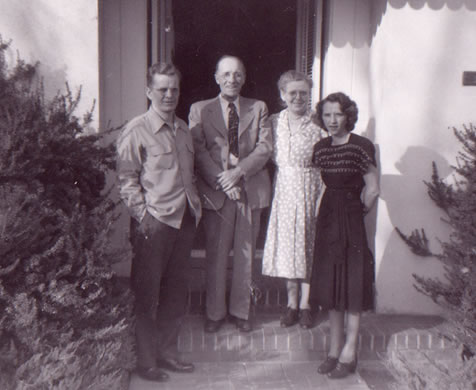
Noen etterkommere:
Arthur, Frank, Amanda og Margaret
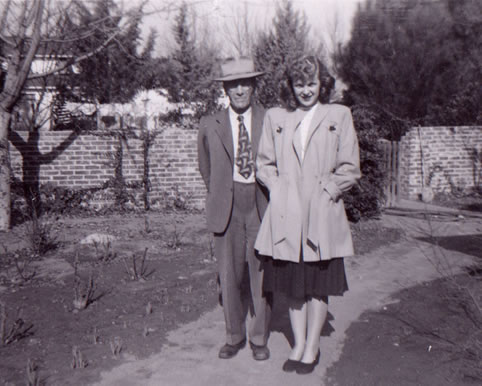
Frank og Betty
5 Fresno
Flyttet hit i 1947.
Der bodde sønnen
Arthur. Frank
døde her i 1948.
2 Carpio
Her arbeidet Frank med
tømmer for Ole Pynten
(Nustad). Her traff han
også Amanda.
De giftet seg i 1907.
4 Bottineau
Hit flyttet de I 1924.
Frank arbeidet i
bank og med
Forsikring.
3 Velva
Her ble Frank
postmester
i 1915 og drev
Kort tid en liten
kolonialbutikk.
1 Wisconsin
Frank reiste hit i
1902 og var tømmerhugger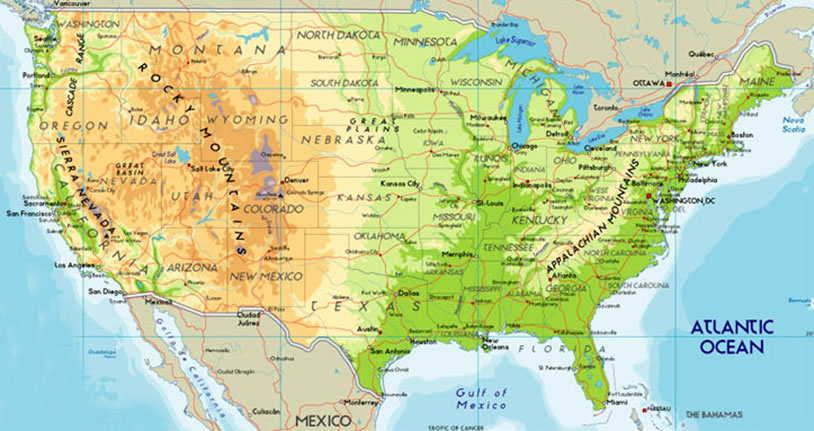



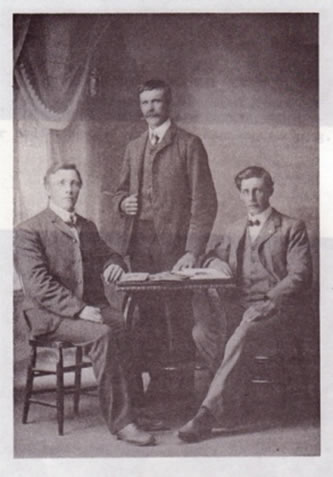
Frank, Ole Pynten (Nustad)
og Erik Rønning
møttes i Minnesota
English version
FRANTZ 1880 – 1948
(From Hedvig Johansen’s booklet about Rønningen and the people who lived there)
In the last years mother lived we talked about her near family and their upbringing. She knew I was collecting material for a short report, and this is what she wrote down as her memories of her older brother Franz:
I remember my brother Frantz went to Mære Agricultural school, it was not usual that the young ones left their homes to get education.
He was 15 years older than me, and I was very happy when he came home from school. Then he used to hoist me up to the roof and sing and dance with me. He had a lovely voice. Even if he was quite busy, he found time to play with me, and this is one of my happiest memories.
Mothers loom was always in the living room and as soon as she had some time on her hands, she sat down, weaving. Mostly there was thick cloth, for suits and pants for my father and brothers, but sometimes it was thinner material for dresses and skirts for us iris.
Whenever the loom was silent, and Frantz was there, he put me on his knees and sang me some funny songs about two pieces of material living on an island.
He also was very active i social life in the community, and he joined the local youth organization when it started around year 1900.
But in 1902, when I was yet not 7 years old, he emigrated to America. I was very sorry when he was no longer part of the home life.
Once I started digging behind the stable, my father, after asking
what I was doing, had to explain that it was impossible to dig a tunnel through to America, which I had hoped to do.
Also my brother Erik, and my two sisters Ingeborg and Marit had left for the same destination.
Luckily Elisabeth and Peder stayed at home
Many letters crossed the ocean in the years to come. Both Frantz and the others got their own families, and pictures were sent both ways. During the First World War, communication was difficult, but between that war and the next, the letters crossed the ocean.
Frantz planned to come and visit his family after the Second World War, but sadly enough he fell ill and died in 1948.
Several years later we had the pleasure of receiving his wife, Amanda and the youngest daughter Elisabet, ealled Betty, with husband Andy. Even Evelyn with family visited us later in Meråker. We really enjoyed their visits
As an answer to our appeal, Betty has written about her father: what she and the other family had learned.
Bettys letter :
Dear Hedvig!
I received your letter a week or so ago. I compared notes with
my brother Arthur who is 73 years old and with my sister Evelyn
who is 72 years old and arrived at some sort of a logical sequence
of events of what happened to "Franz" since he left Norway in 1902.
We do not know why he went to Wisconsin first expect that he was
working in the woods cutting trees etc. He later went to Carpio
to work for Ole Nustad in his lumber yard. This is where he met
our mother who lived on a farm near Carpio and they were married
in 1907. Carpio was a tiny town of perhaps 100 or 200 people.
From there they went to Velva, North Dakota and he managed a
lumber yard for Ole Nustad.
It is our opinion that perhaps Ole Nustad sponsored him to come
to this country and we think that Ole Nustad came from the Meraker
area. Ole Nustad was evidently quite successful in this country
and lived in a big house in Minot, N.D. and drove a big car
according to Arthur - at a time when very few people drove
cars at all. At any rate they evidently had a friendly relationship
throughout the years.
Somewhere in this period of time he tried homesteading near
Williston, N.D. for a matter of a few weeks but it was not
a very successful venture and he relinquished his homestead.
In those days you were supposed to build some sort of a "claim
shack" to "prove up" the land. I think he got as far as actu-
ally starting to build something and decided that this type of
farming was not to his liking. He was always better at working
with his mind than with his hands. None of this amounted to
anything but it is sort of an interesting sidelight in his life.
About 1915 he was appointed postmaster in Velva, a town about
500 people, and held this Job for nine years with Mother occasin-
ally helping him in the postoffice. This was a political appoint-
ment type of job and when there was a change of administration
(we think it was when President Wilson was in power) these types
of jobs would end and someone else would be appointed with
allegiance to the new party in power. So after nine years he lost
his job.
He then bought a small grocery store but it was not to his
liking and sold it after only three months.
In l920's the banks in North Dakota were going broke (this was
before the U.S. government insured all bank deposits) and he
got a job as "receiver of closed banks" which ment checking the
book-work to see if depositors were entitled to any monies left
on account after the banks went broke. Most people lost a lot
of money in these banks that went broke - this is what he
was doing when they moved to Bottineu in 1924. When President
Roosevelt was in power, about 1932 or so, a law was passed in-
suring money deposits in banks and such thing could not happen
today.
In the early 1930's he developed his own insurance and real
estate business in Bottineau. Many landowners left the state
in bad times and he hired tenant farmers for them and managed
the farming and occasionally handled sales for these landowners.
In the late 1930's and early 1940's times were not good for the
farmers in North Dakota and many farmers were going bankrupt.
Considerable amount of farm land was for sale merely for paying
many years of back taxes. Our father had the forsight to invest
in this farmland and rented it out to tenant farmers. This was
his primary source of income.
In 1947 they sold their home in Bottineeu and moved to Fresno,
California (where Arthur lives) and bought a home. Shortly
thereafter he developed cancer of the liver which rapidly spread
throughout his body and in two or three months died of the disease
in May 1948. Mother continued to live alone in their house in
Fresno until she died in 1970.
Our father kept the farmland in North Dakota which was a good
investment and it continues to be farmed on a tenant basis growing
wheat, barley, flax and sunflowers.
In 1944 they bought a cottage at Lake Metigoshe near Bottineau
which is also still in the family. We continue to go back there
even though it is 1600 miles one way from Sacramento and stay at
the lake and try to keep up with the farming ventures in N.D.
North Dakota is part of a vast prairie extending from Canada to
Texas - near Bottineau is a small wooded section bordering
Manitoba, Canada. Lake Metigoshe is rather a small lake with
about 800 cottages with many aspen trees and some birch trees.
Bottineau ha s a population of about 3000 people today and pro-
bably half that many when they lived there.
Otto, born in 1908, was a single man and worked as an airplane
mechanic and died of a heart attack in 1963.
Arthur was born in 1910 and works in life insurance. Their son
Jim is a bone surgeon and Mary Frances's husband also works in
the insurance business.
Evelyn was born in l9ll and married an ingeneer for Boeing Aircraft
in Seattle, Washington. Mary Helen is a stewardess, Carolyn is an
accountant, and John works for the Dept. of Agriculture inspecting
imports of agriculture for bugs and diseases.
Betty (Elisabeth) was born in 1927 and married a teacher.
Karen works for a printing firm, Janet is a bank teller and Marti
is a senior in high school."
Betty ends her letter by concluding that the situation in Norway must have been pretty bad, since so many young people left their country to sail to an unknown destination so far away.
Opplysningene nedenfor er hentet fra Hedvik Johansens beretning
om sin bestemor og bestefar, Solaug og Ole Fr. Rønning.
Frantz Rønning 1880 - 1948
I et av de siste årene mor levde snakket vi sammen om hennes nærmeste familie og deres oppvekst. Hun visste at jeg samlet stoff til en liten beretning om dem, og slik skrev hun ned noe av det hun husket om sin storebror Frantz
”Jeg husker at storebror Frantz gikk på Mære Landbruksskole, og at det ikke var så vanlig da at de unge kunne får reise ut for å gå på skole. Han var 15 år eldre enn meg, og jeg syntes det var veldig stas når han kom hjem. Da pleide han å løfte meg høyt oppunder taket i den lavloftede stua på Rønningen. Han hadde en nydelig sangstemme, og han sang og danset med meg. Dette er noe av det jeg husker aller best, for selv om han alltid hadde mye å gjøre, så tok han seg alltid tid til å leike med meg.
Vevstolen til mor sto alltid inne på stua, for så snart hun hadde en ledig stund, satte hun seg for å veve. Det var ofte
vadmel som skulle bli dresser til far og brødre, eller det var tynnere stoff som vi jentene fikk kjoler og skjørt av.
Hvis vevstolen ikke var i bruk når Frantz kom inn, satte han seg der, tok meg på fanget og så sang han alltid den sangen
som jeg syntes var så morsom:
"Eddri, eddri sett, Konsuleia, Mali dans dokk, fillidoffen deia". Han sang også om to lapper som bodde på ei øy, men denne husker jeg ikke like godt. Etter kosestunda i vevstolen løftet han meg høyt opp under taket igjen, danset og sang.
Ellers var han nok mye med på det som skjedde i bygda, bl.a. var han med da Meraker Ungdomslag ble stiftet en gang rundt århundreskiftet.
Men så kom året 1902. Jeg var enda ikke fylt 7 år da storebror emigrerte til USA i september. Jeg sørget veldig over
at han ikke lenger hørte til blant oss i dagliglivet.
En gang begynte jeg å grave og grave bak fjøset. Far kom og spurte hva dette skulle bli, og han måtte forklare meg at det var rent uråd å komme til Amerika ved â grave en tunell gjennom jordkloden, slik jeg hadde håp om. Det var ikke bare storebror Frantz som var emigrert, men også bror Erik og mine
søstre Ingeborg og Marit. Heldigvis hadde jeg Elisabeth og Peder hjemme fremdeles, og ingen av dem dro til Amerika.
Det gikk mange brev over havet i årene som fulgte. Både Frantz og alle våre søsken fikk etter hvert sin egen familie. Det gikk bilder og brev frem og tilbake. Under 1. verdenskrig var det nok heller sparsomt med kommunikasjonene, men desto mere etter denne perioden helt frem til 2. verdenskrig.
Etter 1945 hadde nok Frantz planer om å komme en tur tilbake til Heimbygda for å hilse på sine søsken. Dessverre ble han alvorlig syk og døde i 1948.
Mange år senere hadde vi gleden av å ta imot hans kone, Amanda, og deres yngste datter, Elisabeth, kalt Betty og hennes mann, Andy.
Senere kom også Evelyn m/mann og datter og sønn på besøk til Meraker.
Hun er eldste datter i Frantz' familie. Det var en svært hyggelig opplevelse
for oss alle her."
På oppfordring herfra har Betty skrevet litt om sin far, og det er hva hun og hennes søsken hadde fått rede på. Som en tilknytning til
mors beretning følger nedenfor Bettys brev:
Brevet er datert Okt. l3th 1983, og gjengis her på engelsk:
Dear Hedvig!
I received your letter a week or so ago. I compared notes with
my brother Arthur who is 73 years old and with my sister Evelyn
who is 72 years old and arrived at some sort of a logical sequence
of events of what happened to "Franz" since he left Norway in 1902.
We do not know why he went to Wisconsin first expect that he was
working in the woods cutting trees etc. He later went to Carpio
to work for Ole Nustad in his lumber yard. This is where he met
our mother who lived on a farm near Carpio and they were married
in 1907. Carpio was a tiny town of perhaps 100 or 200 people.
From there they went to Velva, North Dakota and he managed a
lumber yard for Ole Nustad.
It is our opinion that perhaps Ole Nustad sponsored him to come
to this country and we think that Ole Nustad came from the Meraker
area. Ole Nustad was evidently quite successful in this country
and lived in a big house in Minot, N.D. and drove a big car
according to Arthur - at a time when very few people drove
cars at all. At any rate they evidently had a friendly relationship
throughout the years.
Somewhere in this period of time he tried homesteading near
Williston, N.D. for a matter of a few weeks but it was not
a very successful venture and he relinquished his homestead.
In those days you were supposed to build some sort of a "claim
shack" to "prove up" the land. I think he got as far as actu-
ally starting to build something and decided that this type of
farming was not to his liking. He was always better at working
with his mind than with his hands. None of this amounted to
anything but it is sort of an interesting sidelight in his life.
About 1915 he was appointed postmaster in Velva, a town about
500 people, and held this Job for nine years with Mother occasin-
ally helping him in the postoffice. This was a political appoint-
ment type of job and when there was a change of administration
(we think it was when President Wilson was in power) these types
of jobs would end and someone else would be appointed with
allegiance to the new party in power. So after nine years he lost
his job.
He then bought a small grocery store but it was not to his
liking and sold it after only three months.
In l920's the banks in North Dakota were going broke (this was
before the U.S. government insured all bank deposits) and he
got a job as "receiver of closed banks" which ment checking the
book-work to see if depositors were entitled to any monies left
on account after the banks went broke. Most people lost a lot
of money in these banks that went broke - this is what he
was doing when they moved to Bottineu in 1924. When President
Roosevelt was in power, about 1932 or so, a law was passed in-
suring money deposits in banks and such thing could not happen
today.
In the early 1930's he developed his own insurance and real
estate business in Bottineau. Many landowners left the state
in bad times and he hired tenant farmers for them and managed
the farming and occasionally handled sales for these landowners.
In the late 1930's and early 1940's times were not good for the
farmers in North Dakota and many farmers were going bankrupt.
Considerable amount of farm land was for sale merely for paying
many years of back taxes. Our father had the forsight to invest
in this farmland and rented it out to tenant farmers. This was
his primary source of income.
In 1947 they sold their home in Bottineeu and moved to Fresno,
California (where Arthur lives) and bought a home. Shortly
thereafter he developed cancer of the liver which rapidly spread
throughout his body and in two or three months died of the disease
in May 1948. Mother continued to live alone in their house in
Fresno until she died in 1970.
Our father kept the farmland in North Dakota which was a good
investment and it continues to be farmed on a tenant basis growing
wheat, barley, flax and sunflowers.
In 1944 they bought a cottage at Lake Metigoshe near Bottineau
which is also still in the family. We continue to go back there
even though it is 1600 miles one way from Sacramento and stay at
the lake and try to keep up with the farming ventures in N.D.
North Dakota is part of a vast prairie extending from Canada to
Texas - near Bottineau is a small wooded section bordering
Manitoba, Canada. Lake Metigoshe is rather a small lake with
about 800 cottages with many aspen trees and some birch trees.
Bottineau ha s a population of about 3000 people today and pro-
bably half that many when they lived there.
Otto, born in 1908, was a single man and worked as an airplane
mechanic and died of a heart attack in 1963.
Arthur was born in 1910 and works in life insurance. Their son
Jim is a bone surgeon and Mary Frances's husband also works in
the insurance business.
Evelyn was born in l9ll and married an ingeneer for Boeing Aircraft
in Seattle, Washington. Mary Helen is a stewardess, Carolyn is an
accountant, and John works for the Dept. of Agriculture inspecting
imports of agriculture for bugs and diseases.
Betty (Elisabeth) was born in 1927 and married a teacher.
Karen works for a printing firm, Janet is a bank teller and Marti
is a senior in high school."
Betty avsluttet brevet med å si at tidene i Norge kunne ikke være særlig gode når unge mennesker i tusenvis forlot landet for å dra halve kloden til et ukjent land.
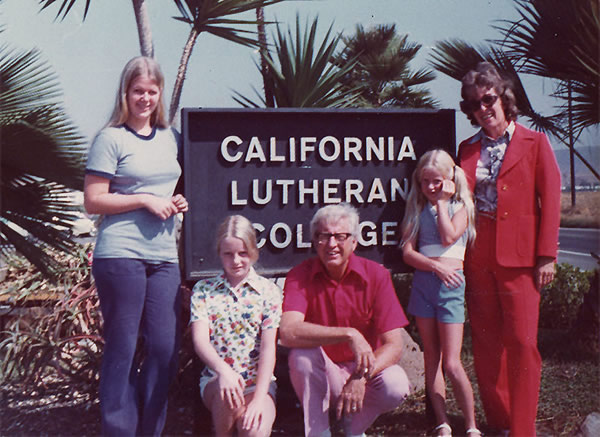
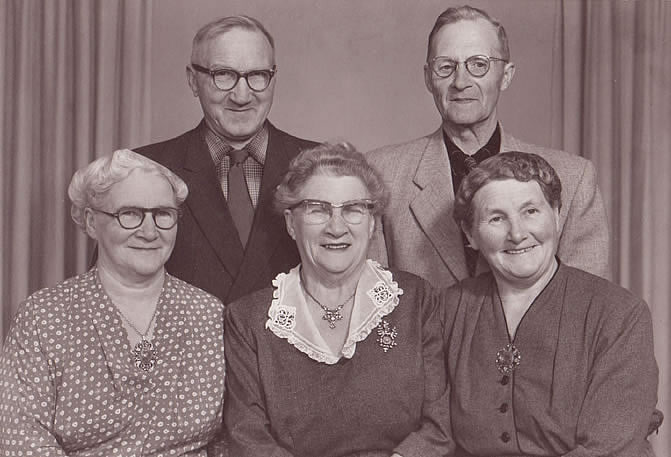
Noen av søsknene til Franz: Peder (Per), Erik, Olga, Marit (Mary) og Elisabeth